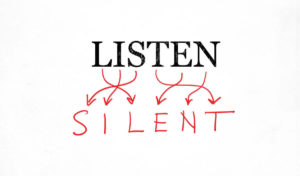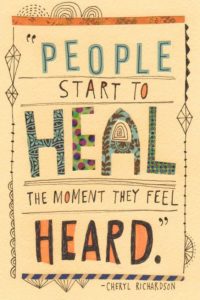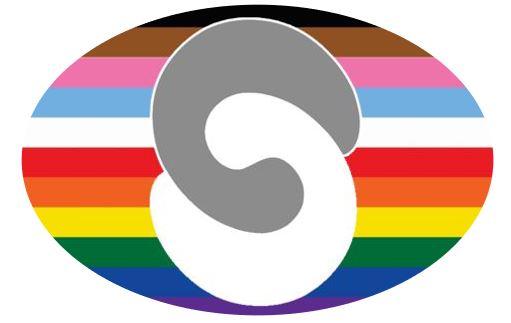I’ve always loved a good conversation.
It’s such a rewarding feeling to connect verbally, exchange ideas and get to know another’s inner world. To see and be seen, hear and be heard.
I’ll freely admit, it’s what excited me most about professional cuddling in the first place. I came into this career with a whole bunch of active listening tools – the kind therapists use. They had fancy names and I had mnemonic devices to remember them all: emotional labeling, reframing, I-messages… I couldn’t wait to put them to good use on clients.
Oh the good I would do with my skills! I would invite introspection, invoke insight and intimacy and leave people feeling inspired. Oh yes.
And that’s when I learned how much better I was at talking than listening.
Who is it About?
The big flaw in how I used to approach listening, was how much I thought it had to do with me.
I had all these ideas of how I could be an intelligent listener. I would be wise and insightful (or witty and hilarious!) and know just what the other person needed. And then, I could say just the right thing in the right moment, and the other person’s life would be magically improved. This was how I would prove my usefulness in the world.
Me, me, me.
Nowadays, I’m a lot clearer about when it’s about me, and when it’s not.
When I’m the listener, I’m learning to make it about the person who is sharing. Instead of listening to respond, I try to stay in tune with what they actually need and want.
Hint: it’s usually not advice.
What We Actually Want from Our Listeners
Have you ever asked yourself what you’re really wanting when you talk?
I’ve noticed when sharing something important to me (or even when it’s not important), I most crave:
– The curiosity & interest of my listener
– My perspective being fully understood
– Validation: the feeling of being interesting, good, right, and smart
While I sometimes do want honest feedback, or a little guidance on what I should do next, this is a very rare occurrence. Most of the time, I really just need some space to talk things out and get some clarity.
It’s in this environment of spaciousness and emotional support that I can usually find my own answers. Every time, the insight I can arrive at on my own is always more potent than someone else’s input.
Listen Like a SAINT
I’d like to share with you my current formula for better listening. I even put it in a handy acronym for ya. Here it is:
Silence
Attention & Presence
Invitation & Permission
Non-judgement & empathy
Trust
1) Silence (a.k.a Say Less/Shhh/Shut Up)
Did you know that listen & silent have the same letters? That blew my mind!
We can’t listen while talking. Most things don’t need a verbal response. I’m learning to just listen and absorb, and just keep making room for the other person with my quiet. My silence is a gift.

2) Attention & Presence
There’s no greater gift than another person’s full attention.
Our ability to pay attention is something that can be fine tuned with practice. Start by putting away all distractions, both external and internal. Practice turning off the inner monologue that can detract from the listening, and just keep redirecting your focus to the person speaking. Cultivating your curiosity about them always helps.
3) Invitation & Permission
Affirming body language language, like simple nodding, or just a few words like “Would you say more?” go a long way.
As the person sharing, I feel safest when I know what I am sharing is welcomed. I soak up the invitation to be me, exactly the way I am.
4) Non-judgement & empathy
What shuts down our listening the quickest is our judgement. When we make judgements, we’ve made decisions for and about the listener. There’s no need for them to share any more.
When judgement creeps in for me (and it does often), I find myself stepping in to correct, or challenge the person speaking. I become defensive about my position. All of a sudden, I’m the one that wants to be heard and I’m not longer doing a good job listening.
It helps to try seeing things from their perspective, and remember that something that is true for us may not be true for somebody else. The more I make room for them to be right, good, and smart, the more connected my listening becomes, and the more validated they will feel.
5) Trust
This sounds simple, but can be the hardest one to execute. Here is where trust is applied:
– Trust that what is being shared is true for them (even if not literally at times)
– Trust in the usefulness of your listening, even if it feels passive
– Trust in their ability to find their own answers, and handle their own life
– Trust that everyone’s opinions can be valid, including your own
When I’m having trouble with listening, like if the feelings of wanting to fix come up, or I notice defensiveness creep in, I ask myself: what am I not trusting here? If I can name it to myself, it helps me to let it go, and go back to simply listening.
I also find trusting in this way is easier when I have my own needs for being heard met. A big part of being a good listener is having your own place to be listened to that can be all about you.

The Labor of Listening
Being a good listener takes a lot more than just having the correct, intelligent responses to what is being said. It certainly goes beyond perfectly executing a list of listening tools!
I’m learning true listening takes a deeper, more nuanced level of effort: emotional work. This type of labor requires me knowing what to do with myself, my thoughts, and feelings as I’m listening to another person. It asks me to challenge what I consider to be right and good. It is a constant practice of trusting and letting go. Sometimes, listening in this way can be painful, as I can be pushed up against my previously held biases. This is challenging stuff.
It’s Worth It!
When I truly listen though, the person speaking gets what they need, and I come away with important perspective. I get to access beauty in another person, in a way I would never otherwise have.
They feel heard, and I’m a better person for it.


Fei, thank you so much for this. I am about to host a free listening event in Ventura and I will share this with the listeners ( who are already quite skilled, but we can always go deeper).
Wonderful!